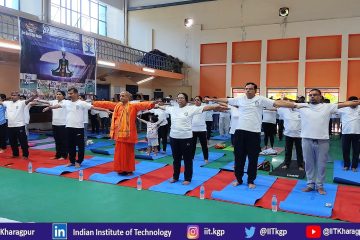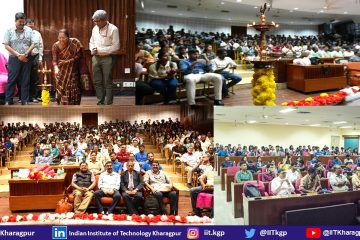 IIT Kharagpur will play a critical role in the preservation of Hugli’s heritage
IIT Kharagpur will play a critical role in the preservation of Hugli’s heritage
Indian Institute of Technology Kharagpur is all set to play a critical role in conservation efforts in Bengal. The Institute’s Department of Humanities and Social Sciences, in association with the University of Liverpool, UK¸ has initiated a pilot project that seeks to protect the rich cultural heritage of the cities and towns along the course of the Hugli river.
“The Hugli River of Cultures Pilot Project, from Bandel to Barrackpore” intends to bring this rich heritage corridor into intense focus. The project is being jointly funded by the by the Arts and Humanities Research Council, UK, and the Indian Council for Historical Research. IIT Kharagpur will be working in close association with Prof. Ian Magedera, the Principal Investigator from the University of Liverpool and his team of researchers.
 As to why the project has decided to focus on this particular area, Prof. Jenia Mukherjee, the principal investigator on the part of IIT Kharagpur, says, “This stretch from Bandel to Barrackpore is thickly loaded with history and culture, and encapsulates the entire trajectory of prosperity to decay that Bengal has been witness to. Besides, these are peripheral cities surrounding Kolkata, and therefore, not getting enough exposure. And yet, like Kolkata, they are also facing the challenges of urbanization. Heritage buildings are making way for malls, multiplexes and so on.”
As to why the project has decided to focus on this particular area, Prof. Jenia Mukherjee, the principal investigator on the part of IIT Kharagpur, says, “This stretch from Bandel to Barrackpore is thickly loaded with history and culture, and encapsulates the entire trajectory of prosperity to decay that Bengal has been witness to. Besides, these are peripheral cities surrounding Kolkata, and therefore, not getting enough exposure. And yet, like Kolkata, they are also facing the challenges of urbanization. Heritage buildings are making way for malls, multiplexes and so on.”
The project focuses on five former trading posts and garrison settlements along the Hugli river: Bandel, Chinsurah, Chandannagar, Serampore and Barrackpore. The researchers believe that there is a “heritage emergency” along the corridor and there is an urgent need to save the traces of the Danish, Dutch, Portuguese, British and French presence in this area, including that of India’s own response to this interlude that produced a rich hybrid culture.
As Prof. Mukherjee puts it, “The idea is to evolve a sense of the ‘Hugli corridor’ by drawing on the collective history of the stretch and the role of the river in this geographical space.” She will be working with Dr Antara Mukherjee, Assistant Professor, West Bengal Education Services. Dr Antara Mukherjee is the lead honorary researcher, and being an inhabitant of Chandannagar, she is involved in qualitative surveys in the private heritage buildings of the project sites and is also playing a key role in sensitizing the public about the need for conservation.
 It is not that consciousness of the need to preserve this historical and cultural heritage is lacking altogether. The problem is that it often has to brace years of inaction, diffidence, outright greed, and, in many cases, narrow parochialism that pits the heritage of one particular area as superior to that of another. Take the longstanding feud between Chinsurah and Chandannagar.
It is not that consciousness of the need to preserve this historical and cultural heritage is lacking altogether. The problem is that it often has to brace years of inaction, diffidence, outright greed, and, in many cases, narrow parochialism that pits the heritage of one particular area as superior to that of another. Take the longstanding feud between Chinsurah and Chandannagar.
The project aims to involve burgeoning grassroots volunteer groups in the understanding and promotion of the hybrid Indian-European domestic architecture, contemporary cultural practices and memory that is close to being erased owing to India’s rapid urbanization. The goal is not to preserve these in “aspic”, says the project’s website, but to “work with the people in these places to adapt and use them for their own purposes”.
As Prof. Jenia Mukherjee puts it, the people are the “owner-custodians” of this rich heritage. That is the sense the researchers are trying to instill in the people they are working with. During the few surveys undertaken before the project was launched, this thought was communicated. It is reinforced in each public interaction. Take for example, the exhibition organized on March 25-29 at Chandannagar under the aegis of the Institut de Chandernagore which got an overwhelming public response.
 While elaborating on the project’s aim to inculcate a “participatory approach”, Prof. Jenia Mukherjee talks about how an “elders’ council”, formed of the elderly who are passionate about conserving the cultural heritage of their locales, had been invited to the photography exhibition at Chandannagar. They were not only welcomed to attend, but were given a sense of ownership of the project through the exhibition that showcased the distinct heritage (often embodied in their own places of residence), they are keen on preserving.
While elaborating on the project’s aim to inculcate a “participatory approach”, Prof. Jenia Mukherjee talks about how an “elders’ council”, formed of the elderly who are passionate about conserving the cultural heritage of their locales, had been invited to the photography exhibition at Chandannagar. They were not only welcomed to attend, but were given a sense of ownership of the project through the exhibition that showcased the distinct heritage (often embodied in their own places of residence), they are keen on preserving.
Dr Helle Jorgensen, the UK Co-PI of the project, writes as part of her fieldwork on Perceptions of Cultural Heritage in Chandannagar, “In Chandannagar multiple layers of history impact on how the urban environment is experienced and valued, ranging from deeper histories of trade and movement in and beyond West Bengal to histories of interaction with the many European colonial powers that were settled along the Hugli River, as well as the subsequent fight for independence, and the more recent histories of urban growth and change in which the closeness to the megacity of Kolkata make a growing imprint on the development of Chandannagar. In this context understanding multiple and, at times, competing voices become essential to understand what might be experienced as heritage in Chandannagar and how it is valued.”
 The project has been trying to connect people – the multi-stakeholders who include the local people as well as the government, artists, conservationists, architects, historians and others – through various ways. There has been a roundtable conference, including many of these groups, at the British Council, Kolkata on April 6, where participants discussed laws that needed to be mobilized, avenues of funding, as well as ways to get over apathy of private heritage property owners towards conservation. Prof. Partha Pratim Chakrabarti, Director IIT Kharagpur, who was a special guest at the proceedings, shared with the congregation the perspective that has motivated IIT Kharagpur’s SandHI (Science and Heritage Initiative) that seeks to preserve heritage while developing the region “through a knowledge economy where the modern and heritage have a harmonious and caring relationship.” This convergence, he said, is one of the key strategies to make the venture successful.
The project has been trying to connect people – the multi-stakeholders who include the local people as well as the government, artists, conservationists, architects, historians and others – through various ways. There has been a roundtable conference, including many of these groups, at the British Council, Kolkata on April 6, where participants discussed laws that needed to be mobilized, avenues of funding, as well as ways to get over apathy of private heritage property owners towards conservation. Prof. Partha Pratim Chakrabarti, Director IIT Kharagpur, who was a special guest at the proceedings, shared with the congregation the perspective that has motivated IIT Kharagpur’s SandHI (Science and Heritage Initiative) that seeks to preserve heritage while developing the region “through a knowledge economy where the modern and heritage have a harmonious and caring relationship.” This convergence, he said, is one of the key strategies to make the venture successful.
In April, there were heritage site visits in Chandannagar and Srirampur, followed by a river-symposium. Project team members, including academicians, photographers, volunteers and invited resource persons (secretary of the West Bengal Heritage Commission and municipal planners) participated in the day-long programme. On August 23, 2018, a meaningful meeting and exchange took place with school teachers of Chandannagar at the Chandannagar Municipal Corporation to sensitize them about the heritage fest which is scheduled for November 25 at Rabindra Bhavan. The Hugli Heritage Fest will be using technology such as iPads and apps to promote young people’s interest in the unique heritage of Chandannagar and the other four Hugli cities of Bandel, Chuchura, Srirampur and Barrackpur. Students from classes 9 to 12 will be sensitized about the unique domestic built, public monument and intangible heritage of Hugli and how the river forms a conduit between the five cities. There will quizzes, debate and a drawing competition on the day.
 Meanwhile, both the Indian and UK team are conducting their fieldwork at the site. There is an additional spectre – two boys who are often seen whizzing around Chandannagar in a Toto, and descending from time to time to photograph domestic and public heritage sites with a red camera. They are Mayukh Sengupta and Indrajit Mondal, two founder members of the project’s GPS-enabled heritage photography team. Guided by Ramanuj Konar and using the unique archive of images of the city’s recent past gifted to the project by Mr Patit Paban Haldar, this team has been assembling material for the project’s free Layar App. This will allow any location enabled smartphone user in Chandannagar to point their camera at important houses and monuments and to see, superimposed on the actual real-time image an historical image taken from the same angle of that place, ten, twenty and maybe a hundred and twenty years ago.
Meanwhile, both the Indian and UK team are conducting their fieldwork at the site. There is an additional spectre – two boys who are often seen whizzing around Chandannagar in a Toto, and descending from time to time to photograph domestic and public heritage sites with a red camera. They are Mayukh Sengupta and Indrajit Mondal, two founder members of the project’s GPS-enabled heritage photography team. Guided by Ramanuj Konar and using the unique archive of images of the city’s recent past gifted to the project by Mr Patit Paban Haldar, this team has been assembling material for the project’s free Layar App. This will allow any location enabled smartphone user in Chandannagar to point their camera at important houses and monuments and to see, superimposed on the actual real-time image an historical image taken from the same angle of that place, ten, twenty and maybe a hundred and twenty years ago.
The project’s team members are supposed to come up with a diverse toolkit of cultural documentation, including a substantive Heritage Management Strategy, an hour-long documentary film, a postcard book, recorded eyewitness testimony, an augmented reality App. These will be underpinned by academic research and directed at securing funds for preservation and access, based on mutual consent and for the benefit the greatest number of sectors in civil society.
As the project objective puts it, this will allow the heritage activists and owner-custodians of the grand houses of Hugli to ‘talk heritage’ with nationally and internationally accredited documentation and visuals in the local Bengali language (and in English and French) to the private sector, and to local and national governments which are yet to seriously plan their own heritage projects.



